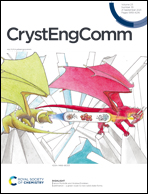X-ray characterisation of the basal stacking fault densities of (11![[2 with combining macron]](https://www.rsc.org/images/entities/char_0032_0304.gif) 2) GaN†
2) GaN†
Abstract
The diffuse scattering from basal plane stacking faults (BSF) of (11![[2 with combining macron]](https://www.rsc.org/images/entities/char_0032_0304.gif) 2) GaN layers was observed by laboratory X-ray diffraction (XRD) systems. To observe the diffuse scattering, the (11
2) GaN layers was observed by laboratory X-ray diffraction (XRD) systems. To observe the diffuse scattering, the (11![[2 with combining macron]](https://www.rsc.org/images/entities/char_0032_0304.gif) 2) GaN samples were oriented in the [
2) GaN samples were oriented in the [![[1 with combining macron]](https://www.rsc.org/images/entities/char_0031_0304.gif) 2
2![[1 with combining macron]](https://www.rsc.org/images/entities/char_0031_0304.gif) 0] zone for 10
0] zone for 10![[1 with combining macron]](https://www.rsc.org/images/entities/char_0031_0304.gif) l and 20
l and 20![[2 with combining macron]](https://www.rsc.org/images/entities/char_0032_0304.gif) l series of reflections or in the [
l series of reflections or in the [![[4 with combining macron]](https://www.rsc.org/images/entities/char_0034_0304.gif) 5
5![[1 with combining macron]](https://www.rsc.org/images/entities/char_0031_0304.gif) 0] zone for 21
0] zone for 21![[3 with combining macron]](https://www.rsc.org/images/entities/char_0033_0304.gif) l series. The profiles of the characteristic diffuse intensity streaks (parallel to [0001]) were fitted with a linear combination of area normalised Gauss and Lorentz functions. The area of the Lorentzian contribution correlated with the BSF density measured by cathodoluminescence, electron channeling contrast imaging, and transmission electron microscopy for densities between 103 cm−1 to mid 105 cm−1, and hence allows for the quantification of the BSF density. The diffuse X-ray scattering of different reflections also suggests that the I1 type BSFs dominate in our samples. This makes XRD a strong method to quantify BSF densities over the whole range, with the added advantage of being non-destructive.
l series. The profiles of the characteristic diffuse intensity streaks (parallel to [0001]) were fitted with a linear combination of area normalised Gauss and Lorentz functions. The area of the Lorentzian contribution correlated with the BSF density measured by cathodoluminescence, electron channeling contrast imaging, and transmission electron microscopy for densities between 103 cm−1 to mid 105 cm−1, and hence allows for the quantification of the BSF density. The diffuse X-ray scattering of different reflections also suggests that the I1 type BSFs dominate in our samples. This makes XRD a strong method to quantify BSF densities over the whole range, with the added advantage of being non-destructive.
![Graphical abstract: X-ray characterisation of the basal stacking fault densities of (11 [[2 with combining macron]] 2) GaN](/en/Image/Get?imageInfo.ImageType=GA&imageInfo.ImageIdentifier.ManuscriptID=D1CE00627D&imageInfo.ImageIdentifier.Year=2021)
- This article is part of the themed collection: Crystal Growth


 Please wait while we load your content...
Please wait while we load your content...
![[2 with combining macron]](https://www.rsc.org/images/entities/h2_char_0032_0304.gif) 2) GaN
2) GaN